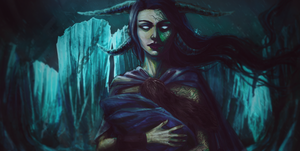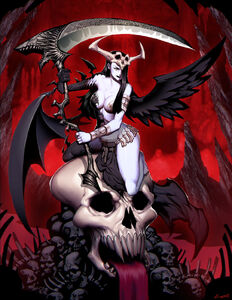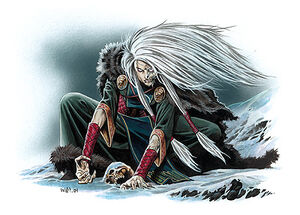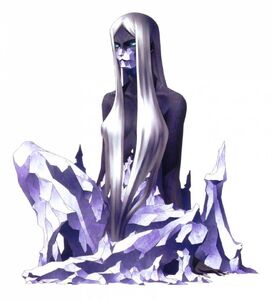| “ | If all things in the world, alive or dead, weep for him, then he will be allowed to return to the Aesir. If anyone speaks against him or refuses to cry, then he will remain with Hel. | „ |
| ~ Hel in the Prose Edda. |
Hel (also known as Hela), also referred to as the "Two-Faced Terror", is an ancient goddess of the dead within the Norse mythology who presides over her namesake realm Helheim which serves a basis for the Christian concept of Hell as well as where she receives a portion of the dead. She is quite usually described as a horrible hag, half dead and half alive, with a gloomy and grim expression. Her face and body are those of a living woman, but her thighs and legs are of a corpse, mottled and moldering.
Biography[]
It is said that once the gods found that these three children are being brought up in the land of Jötunheimr, and when the gods "traced prophecies that from these siblings great mischief and disaster would arise for them" then the gods expected a lot of trouble from the three children, partially due to the nature of the mother of the children, yet worse so due to the nature of their father.
After this discovery, the viking god Odin of Asgard sent the gods to gather the children and bring them to him. Upon their arrival, Odin threw Jörmungandr into "that deep sea that lies round all lands, " whereas Fenrir remained in Asgard under the Gods' care and Hel assigned to rule Helheim, the realm of the dead she held dominion over, citing that she must "administer board and lodging to those sent to her, and that is those who die of sickness or old age." While it can be inferred the motive behind her assignment there being to ensure that her dark powers would be used for her fitting role, Hel nonetheless contented with her newfound position.
After the death of Baldr at the hands of Loki, the goddess Frigg asks who among the Aesir will earn "all her love and favor" by riding to Hel, the location, to try to find Baldr, and offer Hel herself a ransom. The god Hermodr volunteers and sets off upon the eight-legged horse Sleipnir to Hel. Hermodr arrives in Hel's hall, finds his brother Baldr there, and stays the night. The next morning, Hermodr begs Hel to allow Baldr to ride home with him, and tells her about the great weeping the Aesir have done upon Baldr's death. Hel says the love people have for Baldr that Hermodr has claimed must be tested. This test being that if all the things in this world, living or dead, mourn for Baldrr then he will return to the land of the living. If one refuses, then he will remain in her domain. All beings except one named Þökk weeped over his death, not only resulting Baldr to stay in Helheim, but also alarmed the Gods about Loki's betrayal.
Attestations and Theory[]
Hel is attested in the Poetic Edda, compiled in the 13th century from earlier traditional sources, and the Prose Edda, written in the 13th century by Snorri Sturluson. In addition, she is mentioned in poems recorded in Heimskringla and Egils saga that date from the 9th and 10th century respectively. An episode in the Latin work Gesta Danorum, written in the 12th century by Saxo Grammaticus, is generally considered to refer to Hel, and Hel may appear on various Migration Period bracteates.
In the Poetic Edda, Prose Edda, and Heimskringla, Hel is referred to as a daughter of both the divine trickster Loki and the immortal giantess Angrboda (his first wife), and to "go to Hel" is to die. In the Prose Edda book Gylfaginning, Hel is described as having been appointed by Odin as ruler of a realm of the same name, located in Niflheim. In the same source, her appearance is described as half-black and half-flesh coloured and as further having a gloomy, down-cast appearance. The Prose Edda details that Hel rules over vast mansions, her servants in her underworld realm, and as playing a key role in the attempted resurrection of the god Baldr. She cares for the ones that have died of age or sickness and sends "wolfish murderers," "men who seduce another's faithful wife," and oath-breakers to Nástrand where the lindworm Nidhögg dwells.
Scholarly theories have been proposed about Hel's potential connections to figures appearing in the 11th century Old English Gospel of Nicodemus and Old Norse Bartholomeus saga postola, potential Indo-European parallels to other deities that reigns over the dead such as Bhavani, Kali, and Mahakali, and her origins.
Appearance[]
Hel is a female jötunn whose beautiful on one side yet decayed on the other (the decayed half is not necessary rotting and zombie-like however, as some argued it merely corpse-like in color). Thought her distinct appearance unnerved even stout-hearted heroes and Gods alike, the dead admired her by contrast.
She is sometimes accompanied by the blood-stained hound Garm who also acts as the guard of the Gate of Helheim and the mortal enemy of Týr in Ragnarök.
Personality[]
Hel is arguably the least malevolent of three siblings. She is generally apathetic and detached from everyone, rather than evil like her portrayals in popular culture. Despite her initial animosity towards the Æsir, for both casting her into Helheim at which she allowed to have dominion over, Hel eventually accepted her role as the ruler of her namesake realm. She is grim and fierce, merciless in destroying those who offend her. On par with her melancholic state of mind, Hel rarely conveys emotion, except for the occasional mocking smile.
Hel appeared to hold a great deal resentment towards her father Loki for being born as half-undead Jötunn, yet the fact that she did nothing to prevent Naglfar, a supernatural Viking longship said to be made of nails of the deceased, from being seized by a horde of dishonourable dead in a bid to assist his Jötnar army against the Gods during Ragnarök indicated her willingness to put it aside for assisting the latter and her siblings Jörmungandr and Fenrir in their war, something which motivated by their common desire to avenge their progenitor Ymir. This in turn, confirmed her dangerous nature as Odin and his fellow Norse deities feared.
Powers and Abilities[]
- Jötunn Physiology: Hel is the half-dead Jötunn and daughter of Angrboða and Loki who born with all the conventional abilities of the Jötnar. After being placed in Hel by the Æsir, she developed new power associated with necromancy which complimented her role as the ruler of Helheim appointed by Odin the Allfather himself.
- Immortality: As with her fellow Jötunn, Hel can live forever and does not rely on the mystical apples of Iðunn to maintain her youthful appearance. Whereas, half of her body is alive and healthy, the rest looked dead and decomposing. Yet she is not bothered by such a condition in any way, Hela is virtually in a state between alive and undead.
- Death-Force Manipulation: Hel can has immense supernatural powers of necromancy, a force in every mortals which causes things to wither, rot, weaken, and eventually die for various feats such as;
- Age Manipulation: Hel can utilize death force to induce death on her victims through accelerated aging.
- Disease Manipulation: Hel can utilize death force to cause and spread harmful disease that can kill those it touches. She automatically senses all deaths by disease, accident, or poison, and anything which occurs in graveyards.
- Death Inducement: Hel can utilize death-force to instantly kill a mortal.
- Rot Inducement: Hel can utilize death-force to cause things, organic matter in particular, to decay into nothingness.
- Resurrection: Hel can utilize death force to perform necromantic feats from reviving the deceased to commanding the dead to do her bidding. She had promised to revive Baldr and return him to the Æsir if her conditions were met.
- Death Empowerment: Not surprisingly, Hel can gain strength from death itself, perhaps through souls of deceased mortals who entered her namesake realm.
- Personal Domain/Underworld Lordship (Helheim): Hel has established the namesake realm she assigned to by Odin as the very place in which she has absolute power, making it an extension of her very being.
- Esoteric Ice Manipulation: Hel's authority over Helheim enables her to tap on its cold aspect to perform cryokinetic feats achievable at its fullest while within the realm.
- Limited Omniscience: Hel possesses the ability to have unlimited understanding and awareness of everything within Helheim.
- Graveyard Lordship: Befitting to her epithet Howes'-Warder, Hel held authority and control over burial grounds and everything on them, such as spirits, the dead, corpses, skulls, etc., thus able to draw power from them as with Helheim.
Modern Media[]
With her major role in Norse mythology, Hel has been used in countless works of fiction. Notable examples are:
- Hel: A playable character in the MOBA videogame Smite.
- Hela: A major antagonist in Marvel Comics.
- Hela: A main antagonist of the Marvel Cinematic Universe movie called Thor: Ragnarök.
- Hel: The minor antagonist and supporting anti-heroine in Rune and Rune II.
Gallery[]
Trivia[]
- The name shares the origin of the English word for "Hell", and means "hidden", "concealed".
- The phrase "Go to Hell" actually originated from "Go to Hel" meaning the same thing, which is "go die", since Hel was the name for both the ruler of the underworld as well as the name of the underworld.
- Hel's status as Goddess of Death is the exaggeration of her overall role because in Norse mythology, she begrudgingly shares role of Death Deity with Odin and Freya, latter who have authority over honorable deceased just as the Daughter of Loki having similar authority to the rest.







